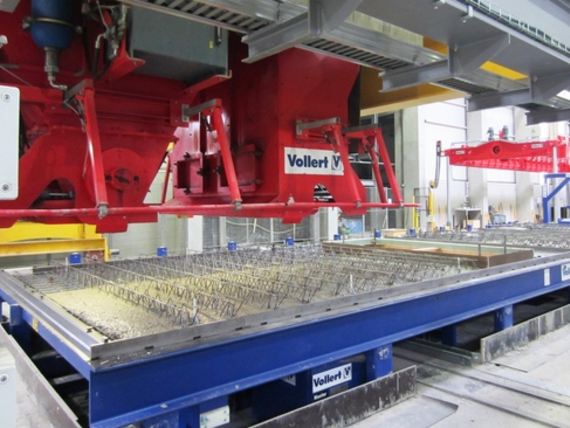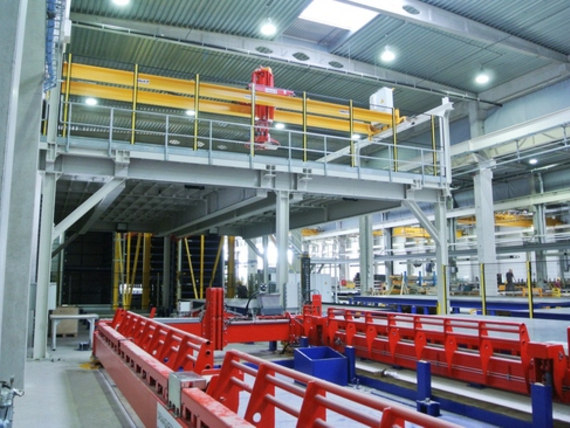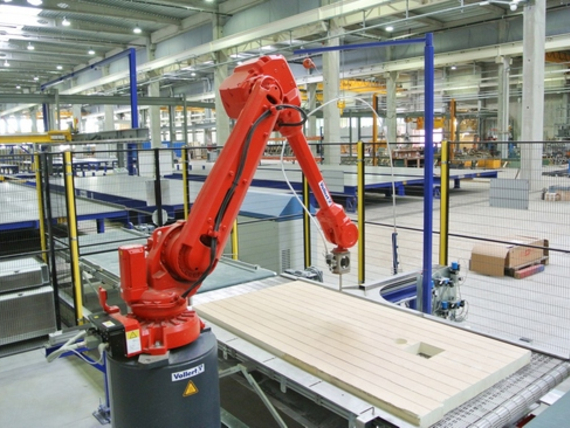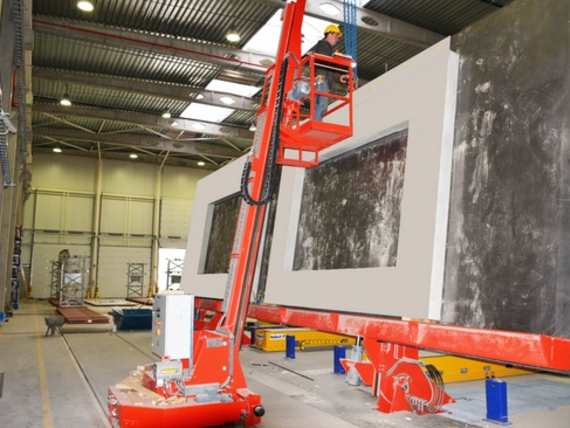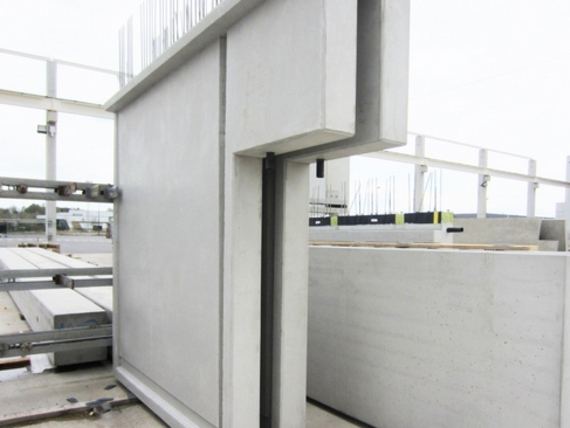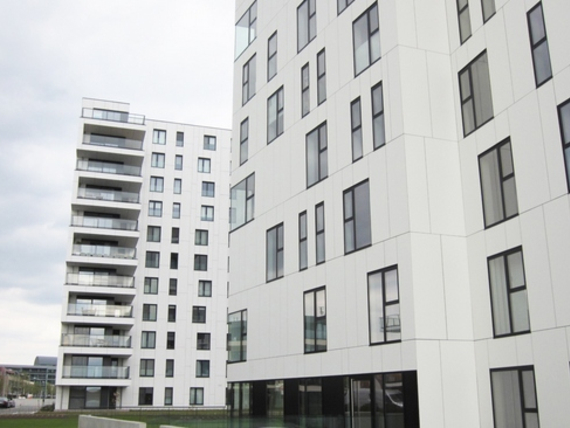Cordeel Group focuses on turn-key solutions for its customers across Europe in its building projects. Modern architecture in precast concrete construction uses precast solid, double and sandwich concrete parts. Larger building projects and the increasing regional expansion, in particular towards Eastern Europe, led to the production of a new state-of-the-art precast concrete plant in Temse near Antwerp. Several production lines and a smart circulation concept ensure maximum plant variability. The output volumes can be adjusted depending on order situation and the respective building project. "For this new construction project, we have chosen Vollert as an experienced know-how partner who not only supplies state-of-the-art plant technology, but also and in particular precisely coordinates the production-technical processes with our demands," Ivo de Mulder, Production Manager of Cordeel Group, explains.
State-of-the-art machine technology and variable production processes
"We produce solid and sandwich concrete parts, as well as semi-finished parts with high output capacities in parallel in the pallet circulation system. This is done on limited space. It is a challenge that has been considered and solved in close coordination with the customer and the architects even during the advance plans," says Philippe Marrié, responsible Senior Sales Manager at Vollert. Machine technology and the degree of automation are also important factors in modern precast concrete parts factories. "We continually work to improve plant technology in this respect and to optimise the processes with new features and increase capacities," says Marrié.
The modern, attractive architecture is a special characteristic of all projects of Cordeel Group. Several hundred building projects, from exclusive residential facilities to mega shopping malls, industrial buildings, hospitals and school buildings have been completed across Europe in the last few years. The high quality standards that are required in modern precast construction today require defect-free walls and slabs in terms of parts geometry and dimensions. Modern shuttering systems and precise high-performance casing robots play a decisive role in this. "The first work step in the production process surely at the same time is one of the most important ones for the final quality of the final concrete parts," says Ivo de Mulder. For this, a SMART SET2 shuttering robot places the RATEC shuttering profiles precisely onto the prepared circulating pallet at high movement speeds. Pre-plotting of the contours and positioning of the shuttering systems are CAD-/CAM-controlled. The shuttering robot has four simultaneously moving axes. At a process acceleration of 4 m/s2, the horizontal X- and Y-axes move at up to 3 m/s, and the vertical Z-axis at up to 1.6 m/s. A high repeat accuracy results in connection with the gripper, which can be turned by +/- 180°.
Perfect concreting and compaction processes
In addition to the highly automated robot technology in work preparation, important new innovations have been included in the concreting and compaction processes as well. Supplied via a turning-bucket conveyor, a state-of-the-art SMART CAST automatic concrete distributor ensures homogeneous and precise output of the concrete. The output container, which has a maximum capacity of 3 m3, can move crosswise on the concrete distributor bridge in addition to the longitudinal run as well, and thus achieve an output area of up to 3.20 m. A high-performance scanner checks the position of the shuttering profiles and the introduced reinforcement mats again beforehand. The concrete output takes place via a spiked roller/slider construction. The output volume and the spiked roller speed (frequency-controlled) can be optimally set to different concrete consistencies. Hydraulically actuated flat sliders leave out the partial area where no concrete is to be output, e.g. for windows. The slider width adjustment permits optimal adjustment of the outlet width to different concrete types and consistencies (normal concrete, lightweight concrete, etc.). "The twin concrete bucket is a true novelty as well," Philippe Marrié from Vollert explains. "The concrete distributor is the first to have two separate concrete buckets. This way, we can apply not only normal concrete but also coloured exposed concrete". For subsequent cleaning of the concrete inside, the concrete distributor moves into a separate washing station where the twin bucket is manually cleaned of concrete residues and dust. The tipping bucket of the concrete transport system also moves into this washing position for fully automatic cleaning.
The compaction of concrete with a combined VArio COMPACT2 shaking/oscillation station ensures an optimised upper mould of the solid concrete parts in exposed-concrete quality, as well as compaction of the more strongly reinforced double and sandwich walls. The low-frequency oscillation movement is produced by four imbalance drives that compact the concrete. Depending on weight, the imbalances are synchronised differently. This permits optimised circular oscillation movement at low noise development. The desired compaction energy can be set precisely. Additionally, concrete compaction takes place via an integrated high-frequency shaker station. For this, the vibration energy of the eight outer shakers is transferred to the pallet via the roller blocks. A VArio STORE storage and retrieval device running on the ground stores the semi-finished concrete elements in the curing chamber for curing. The fully insulated VArio CURE curing chamber is made up of three covered shelf towers with 13 pallet compartments each and has a special heating system. The circulation pallets are retracted and extended via friction wheels and a rack slider.
For high quality of the exposed concrete of the solid concrete parts, these parts are retrieved from storage again by the storage and retrieval device after a short pre-curing time and transported onwards to a work station above. A bridge-construction blade smoother moves length- and cross-wise and ensures surfaces with smooth moulding. This is ensured by an electrically powered smoothing head with blade adjustment and adjustable rotation speeds. When the desired surface properties have been achieved, the concrete part is returned to the curing chamber for further curing. This work step can also be repeated several times. Once the final curing time has been reached, the pallet is moved to demoulding via a removal compartment.
Optimised processes in double/sandwich wall production
When double or sandwich walls are produced, the storage and retrieval device takes the first circulating pallet from the curing chamber after curing of the first mould and hands it over to the stationary pallet turning device via the transport line. The cured upper mould is clamped on the pallet with hydraulic clamping arms. For the subsequent turning process, lifting cylinders lift the turning frame first. During the rotating movement, the weights are held by a longitudinal stop, ensuring a safe turning process and preventing lateral slipping of the production parts. Firmly installed and manually adjustable spacers help produce different wall thicknesses. Once the first mould has been turned by 180°, the lower mould moves under the turning device. This lowers and connects the two moulds to each other. The wall is produced. The semi-finished part is then compacted again. For this, the fresh concrete of the lower mould is shaken. Synchronous shaking without relative movement of the first and second moulds guarantees for high product quality and prevents concrete de-mixing in the area of the reinforcement.
Production of sandwich concrete parts, however, also requires economic insulation material preparation to produce high-quality walls at large output quantities in strictly organised processes and short periods. For this, the new Cordeel factory relies on the ISO-MATIC 2.0, which permits highly precise and fully automated preparation of insulation material in any desired geometrical shape (drilled circles, diagonals, waves, etc.). The required part dimensions are read from the existing CAD data. This information is used to generate the required cuttings fully automatically. A 6-axis cutting robot uses 4,000 bar water pressure to put the insulation material in the desired geometrical shape with high precision - both in 2D and in 3D. Axis speeds of 175° - 360°/s are reached. Additional drilling or cutting tools for cut-outs of the installation parts or for the sanitary and electrical installations are not necessary. Customer-specific basic settings (present insulation plate thickness, distance and type of the connection rods, etc.) can be integrated easily.
Efficient processes also determine the loading technique. The solid concrete and semi-finished parts are vertically lifted off by a VArio TILT high-performance tilting station. This is done up to a maximum tipping angle of 80°. A hydraulically movable supporting beam moves against the fixed side mould to prevent slipping of the concrete element during tipping. For lifting off, a movable lifting basket is used to attach the lift-off anchor to the wall element first. This increases work safety as compared to a conventional ladder. Loading takes place directly onto inner loader frames.
Perfectly controlled, economically evaluated
Technology at the latest state of the art and perfectly coordinated automation characterise this pant concept. "In particular the flexible work processes enable us to produce diverse precast concrete parts for multiple-floor residential buildings, shopping malls or hospitals. The entire plant configuration and all storage processes are centrally controlled via a modern Unitechnik control computer system," says Philippe Marrié from Vollert. A visualisation computer controls the individual work stations, creates the pallet assignments, routes the pallet transport, administrates removal sequences and curing times.
"The new precast concrete plant in Temse optimally prepares us for expansion of our construction activities across Europe. We have become a true key player in Europe and are looking forwards to the next large construction projects," Ivo de Mulder from Cordeel Group summarises.



